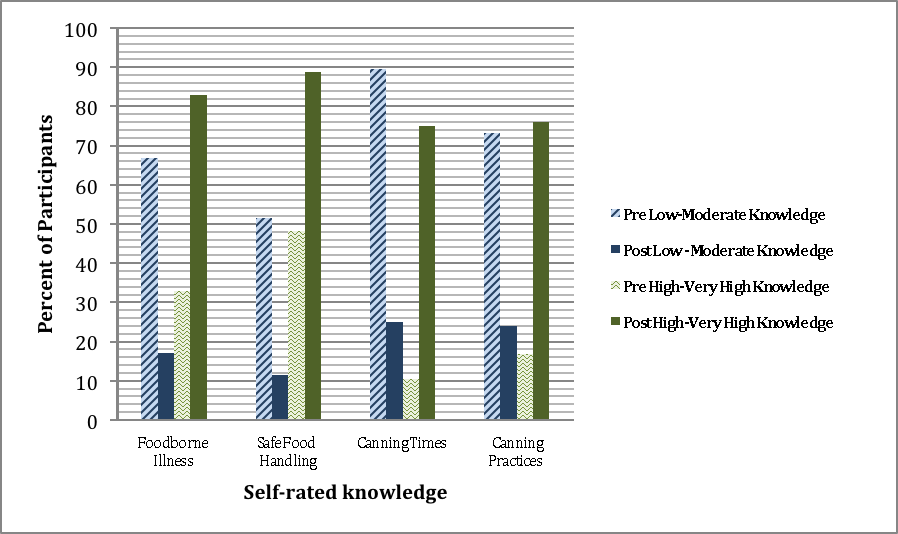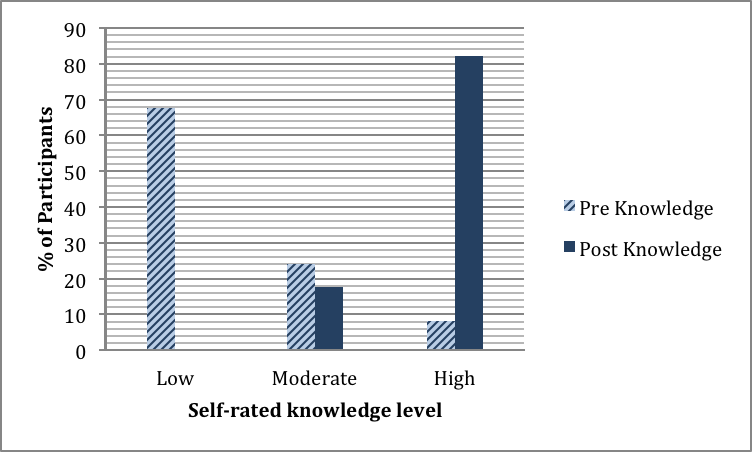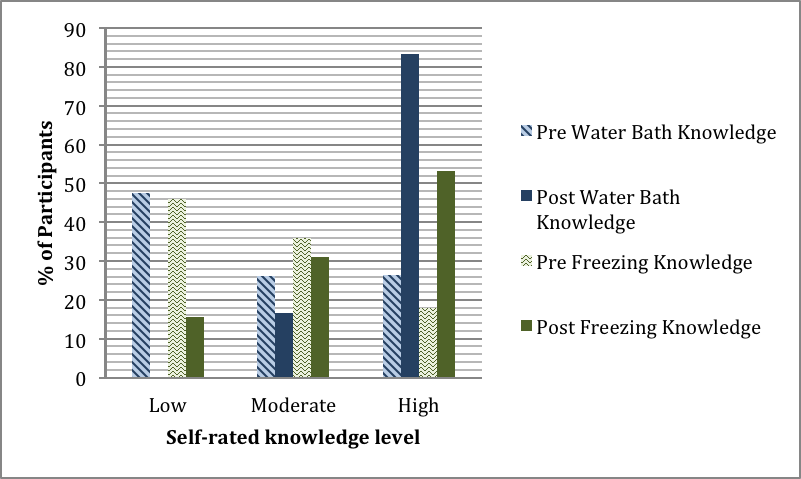 |
August 2014
|
August 2014 // Volume 52 // Number 4 // Tools of the Trade // v52-4tt8
Hybrid Food Preservation Program Improves Food Preservation and Food Safety Knowledge
Abstract
The growing trend in home food preservation raises concerns about whether the resulting food products will be safe to eat. The increase public demand for food preservation information led to the development of the comprehensive food preservation program, Preserve the Taste of Summer (PTTS). PTTS is a comprehensive hybrid food preservation program comprised of online lessons and corresponding in-person workshops. PTTS participants reported increases in knowledge about food preservation food safety and recommended food preservation techniques after participating.
Introduction
The growing trend in home food preservation raises concerns about whether the resulting food products will be safe to eat. The most common cause of foodborne botulism outbreaks in the United States is from home-canned vegetables, most likely attributable to the use of unsafe food preservation techniques (Centers for Disease Control and Prevention, 2013). Date and others (2011) reported that between 1999 and 2008, 75 out of 82 cases (91%) of foodborne botulism outbreaks were due to home-prepared foods. Out of these 75 cases, 33 (44%) were credited to home-canned foods in which the canners did not follow proper canning instructions and ignored signs of food spoilage (Date et al., 2011). The lack of adherence to safe food preservation practices is likely due to the reliance of individuals on incorrect information, with most people seeking canning information from family or friends (Andress & D'Sa, 2007). Thus, it is essential consumers receive research-based education and skills-training on food preservation methods to ensure preserved food is safe to eat.
Development of a comprehensive statewide food preservation program was viewed as an immediate and crucial need in Iowa. In 2009-2010, 28% of calls to the Iowa State University Extension and Outreach (ISU Extension) AnswerLine dealt with food preservation, which represented about a 25% increase from the previous year. In response, the comprehensive food preservation program, Preserve the Taste of Summer (PTTS), was developed. The goal of PTTS is to increase the number of consumers following safe home food preservation practices by increasing:
- Home food preservation-related food safety knowledge
- Recommended food preservation techniques knowledge
Description of PTTS
The PTTS program, http://www.ucs.iastate.edu/mnet/preservation/home.html, is based on the Master Food Safety Advisor program from Colorado State University. The PTTS program is comprised of eight online lessons (approximately 4 hours total), four in-person workshops (4 hours each), and seven supporting publications. This hybrid approach (online and in-person) was selected given budgetary and time constraints of both Extension personnel and consumers.
The online lessons were developed using PowerPoint and voice-over recordings using Adobe software, similar to Driessen (2013). Each in-person workshop provides a hands-on experience for participants to develop skills and learn how to safely preserve a particular food product that they take home. The workshop curriculum includes a brief review of the corresponding food preservation technique, knife skills (includes practicum), basic food safety, and a food preservation practicum using recipes from the So Easy to Preserve cookbook (Andress & Harrison, 2006). Participants can choose to attend any of the four food preservation workshops, after they complete the corresponding online lessons (Table 1).
| Online Lesson Topics | Corresponding Workshops |
| General Overview Lessons (required for all participants) | |
|
Food Safety (35 minutes) Canning Basics (47 minutes) |
Addressed during all workshops |
| Subject specific Lessons | |
|
Canning Acid Foods (20 minutes) Freezing Foods and Storage of Frozen and Refrigerated Foods (36 minutes) |
Hot water bath canning (salsa making) and freezing (Workshop 1)
|
|
Making and Preserving Fruit Spreads ( 29 minutes) Drying Foods (30 minutes) |
Jams and Dehydrating (Workshop 2)
|
| Preparation and Canning of Pickled and Fermented Foods (28 minutes) | Pickle making (Workshop 3) |
| Pressure Canning Low-Acid Foods (33 minutes) | Pressure canning (Workshop 4) |
There are four levels of PTTS participation. The first three levels are for the general public; the fourth level (Professional) is for dietitians (national, approved for up to 20 hours of continuing education) and Family and Consumer Science (FCS) teachers (Iowa only, approved for 1 hour of teacher renewal).
- Bronze, includes general overview lessons and two subject specific lessons, no workshop ($25)
- Silver, same as bronze level plus one corresponding workshop ($50)
- Gold, includes all online lessons and choice of one workshop ($75)
- Professional level, same as gold level and provides continuing education credit ($100).
Methods
The effectiveness of PTTS is measured by surveys. For the online lessons, participants complete a four-question online assessment rating their knowledge regarding: foodborne illness, safe food handling, canning processing times, and recommended canning practices before and after viewing the general overview lessons. For each workshop, participants complete a post-then-pre questionnaire (Rockwell & Kohn, 1989) administered at the end of the workshop.
Findings
Currently there are 94 PTTS registered participants. These participants are primarily Iowa-residing females who are registered at the professional level (n=53, 56.4%) (Table 2).
| Characteristic | Number | Percent (%) | |
|
Gender |
Female Male |
89 5 |
94.7 5.3 |
|
Participation Level |
Bronze Silver Gold Professional: Teacher Professional: Dietitian |
5 14 22 13 40 |
5.3 14.9 23.4 13.8 42.6 |
|
Location |
Iowa Minnesota Missouri Nebraska Kansas Illinois Canada |
69 6 5 4 3 5 2 |
73.4 6.4 5.3 4.3 3.2 5.3 2.1 |
All participants reported increased knowledge after viewing the online lessons (Figure 1). Specifically, there was an increase in those reporting "high" post knowledge about canning processing times (64.6%), recommended canning practices (59.3%), foodborne illness (e.g., causes, high risk foods) (50.2%), and safe food handling practices (40.6%).
Figure 1.
Self-Rated Pre and Post Knowledge Levels for Online Lessons

Seventy participants have attended a workshop, with some taking part in more than one. The majority of workshop participants were white females who attended the salsa making and freezing workshop (Table 3). Nearly all reported being "satisfied" with the relevance of the workshop information to their needs, found the information understandable, and would recommend PTTS to others.
| Characteristic | Number | Percent (%) |
|
Gender Female Male No response |
60 8 2 |
85.7 11.4 2.9 |
|
Ethnicity White Latino Other American Indian/Alaskan No Response |
60 3 2 1 4 |
85.7 4.3 2.9 1.4 5.7 |
|
Workshop Attended Hot water bath canning (Salsa Making) and Freezing Jams and Dehydrating Pickle Making Pressure Canning |
23 13 14 20 |
32.9 18.6 20.0 28.6 |
|
Found the information understandable Yes No No Response |
65 1 4 |
92.9 1.4 5.7 |
|
Would recommend PTTS to others Yes No No Response |
67 2 1 |
95.7 2.9 1.4 |
At least 34.1% to 83.3% of workshop participants reported "high" knowledge in their food preservation workshop topic after completing the workshop (Figures 2a-2d). This represents an increase of 74.1% for altitude adjustment, 57% for water bath canning, 43.9% for jam making, 40% for pressure canning, 35.3% for freezing, 32% for dehydrating, and 29.2% for pickle making.
Figure 2a.
Pre and Post Knowledge for Adjusting for Altitude When Canning

Figure 2b.
Workshop 1—Hot water bath Canning and Freezing Pre and Post Knowledge

Figure 2c.
Workshop 2—Jams and Dehydrating Pre and Post Knowledge

Workshop participants stated the information pertaining to food preservation safety was the most important thing they learned. One participant commented, "There were several important things I learned—must follow a tested recipe, [and] the process...." Another reported, "[the most important thing I learned was] pressure by elevation even in a state as flat as Iowa…."
The hands-on experience was viewed as the "best liked" workshop feature. After completing the PTTS program one participant stated, "I would never have attempted home canning before the online lessons. Now I know how to do it correctly and will attempt home canning." Furthermore, the knowledge participants gain is being shared with others: "[I]…feel confident to teach in my [food preservation] classes at school," thus broadening PTTS's impact.
Summary
These findings suggest the PTTS program is effective in increasing self-rated knowledge about food preservation-related food safety and food preservation techniques. The hybrid format of online education and in-person workshops is an effective, time-saving method of promoting comprehensive, researched-based food preservation education to clients that is well-received by both clients and Extension staff to reduce foodborne illness.
References
Andress, E. L., & D'Sa, E. M. (2007). Survey of home canning practices and safety issues in the U.S. Institute of Food Technologists Annual Meeting, Chicago, IL. Retrieved from: http://nchfp.uga.edu/papers/2007/canning_survey.html
Andress, E. L., & Harrison, J. A. (2006). So easy to preserve (5th ed.). Athens, GA: Cooperative Extension/The University of Georgia.
Centers for Disease Control and Prevention (2013). Home canning and botulism. Retrieved from: http://www.cdc.gov/features/homecanning
Date, K., Fagan, R., Crossland, S., MacEachern, D., Pyper, B., Bokanyi, R.,… & Tauxe, R. (2011). Three outbreaks of foodborne botulism caused by unsafe home canning of vegetables- Ohio and Washington, 2008 and 2009. Journal of Food Protection, 74(12), 2090-2096.
Driessen, S. (2013). Food preservation mini-modules offer options for learners and Extension staff. Journal of Extension [On-line], 51(6) Article 6IAW7. Available at: http://www.joe.org/joe/2013december/iw7.php
Rockwell, S. K., & Kohn, H. (1989). Post-Then-Pre Evaluation. Journal of Extension [On-line], 27(2) Article 2FEA5. Available at: http://www.joe.org/joe/1989summer/a5.php




